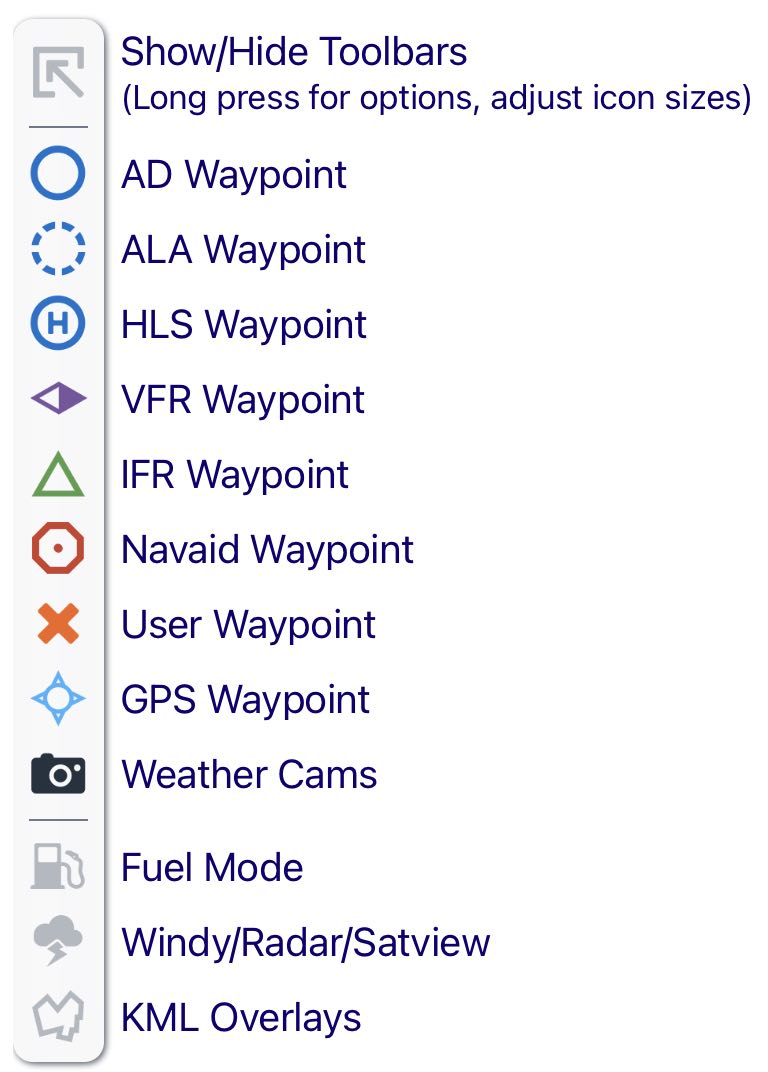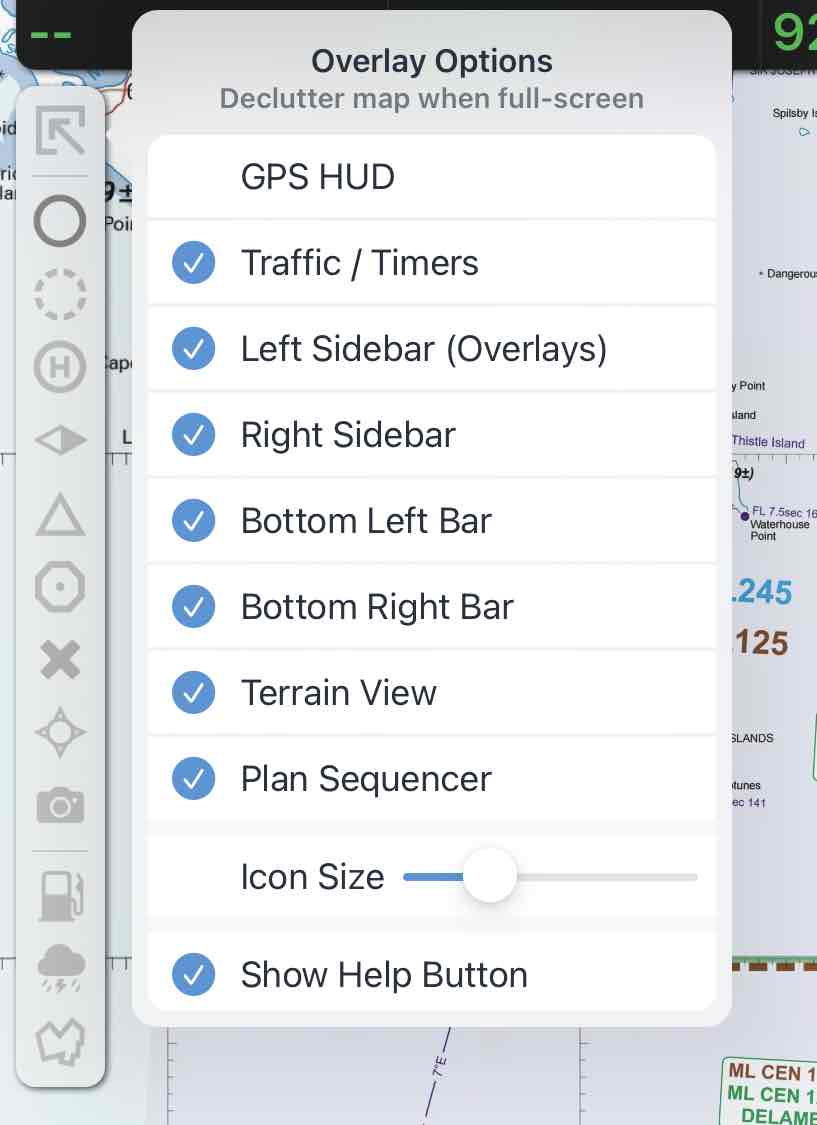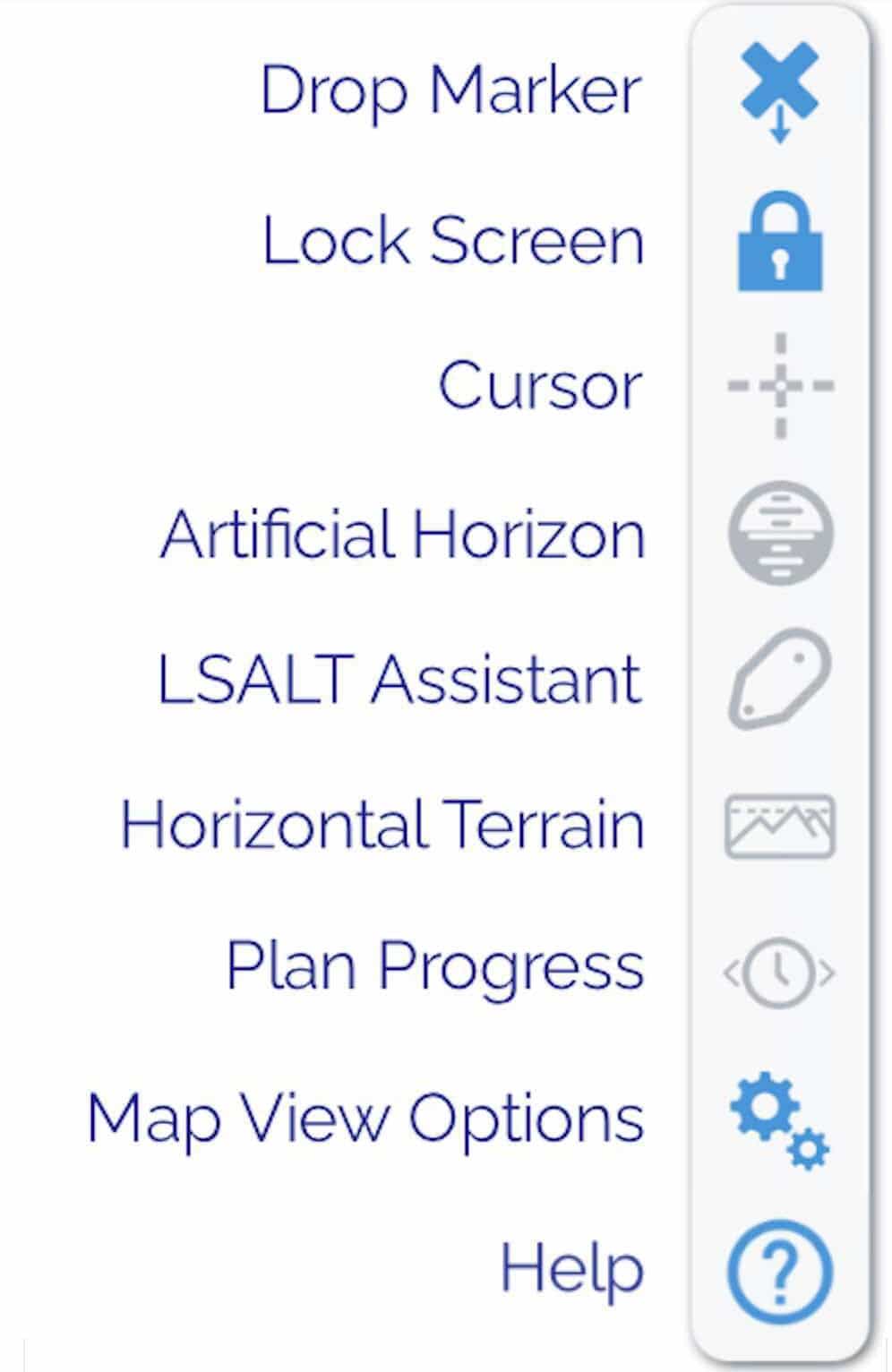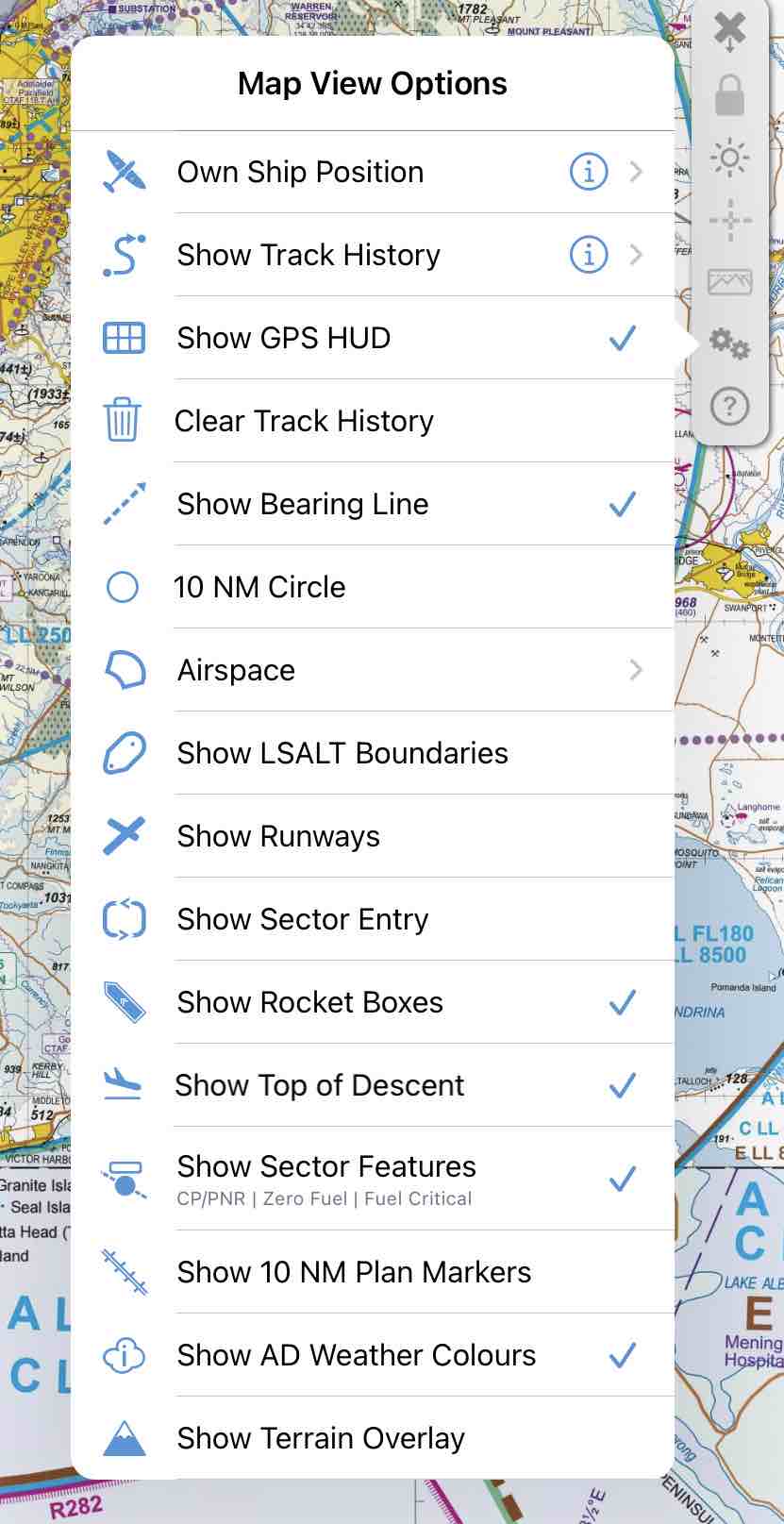2. Map Page¶
2.1. Basic Interaction¶
Firstly, there are a number of things you can do on the map page and likely, while en-route flying, you will spend most of your time here. For this reason, it is important to familiarise yourself with the diverse capabilities provided on this page. Some functionality is available simply by tapping, swiping, pinching or pressing on the map. Other functionality is available via buttons at the top, side and bottom of the screen.
The operations available are:
- Pan map
Press, hold and drag your finger on the screen
- Zoom
‘Pinch zoom’ is achieved by placing your thumb and forefinger on the screen at the same time and pressing, holding (briefly) and moving them apart (zoom in) or together (zoom out).
One finger zoom can be achieved by tapping twice on the map, but on the second tap keep your finger in contact with the screen and swipe up or down to zoom in or out.
- Measure
The same as for zoom, but press and hold your thumb and forefinger until a ruler appears. Then while keeping your fingertips contacting the screen, manipulate them to adjust the position of the ruler. Tap and hold on the ruler to reveal more options: distance unit, course type (rhumb or great circle), and bearing type (ºT or ºM).
- Enter a plan
See Planning
- Get the weather
Tap near an aerodrome (AD). The Closest Points popup will appear, tap on the AD in this popup. Tap ‘Wx/Notams’ in the subsequent menu.
- Create a User Waypoint
Tap on the map where you want the waypoint. Tap on the ‘+’ in the top left corner of the subsequent ‘Closest Points’ popup. Tap ‘Add User Waypoint’.
- Follow your progress as you fly (moving map mode)
See Map Mode button later in this chapter.
View Grid LSALTs
Access various IFR aids
Find your GPS location
2.2. Map Interaction¶
Tap once anywhere on the map and the ‘Closest Points’ popup will appear (Image 2.1). This list shows the waypoints closest to where you tapped on the map. Below and beside each item in the list is some information about the waypoint. If you have tapped near an aerodrome then it will be prioritised and appear as the first entry in the list, and some more quick actions are associated with it.
For easy reference, the runway displayed on this page is appropriately coloured to reflect the surface type. The colours are: brown = dirt/gravel, green = grass, grey = tarmac. Where available, there is a small diagram of the runway layout and a windsock next to the airfield name. The windsock changes direction based on the current METAR wind to give you a quick indication of which runway might be in use.
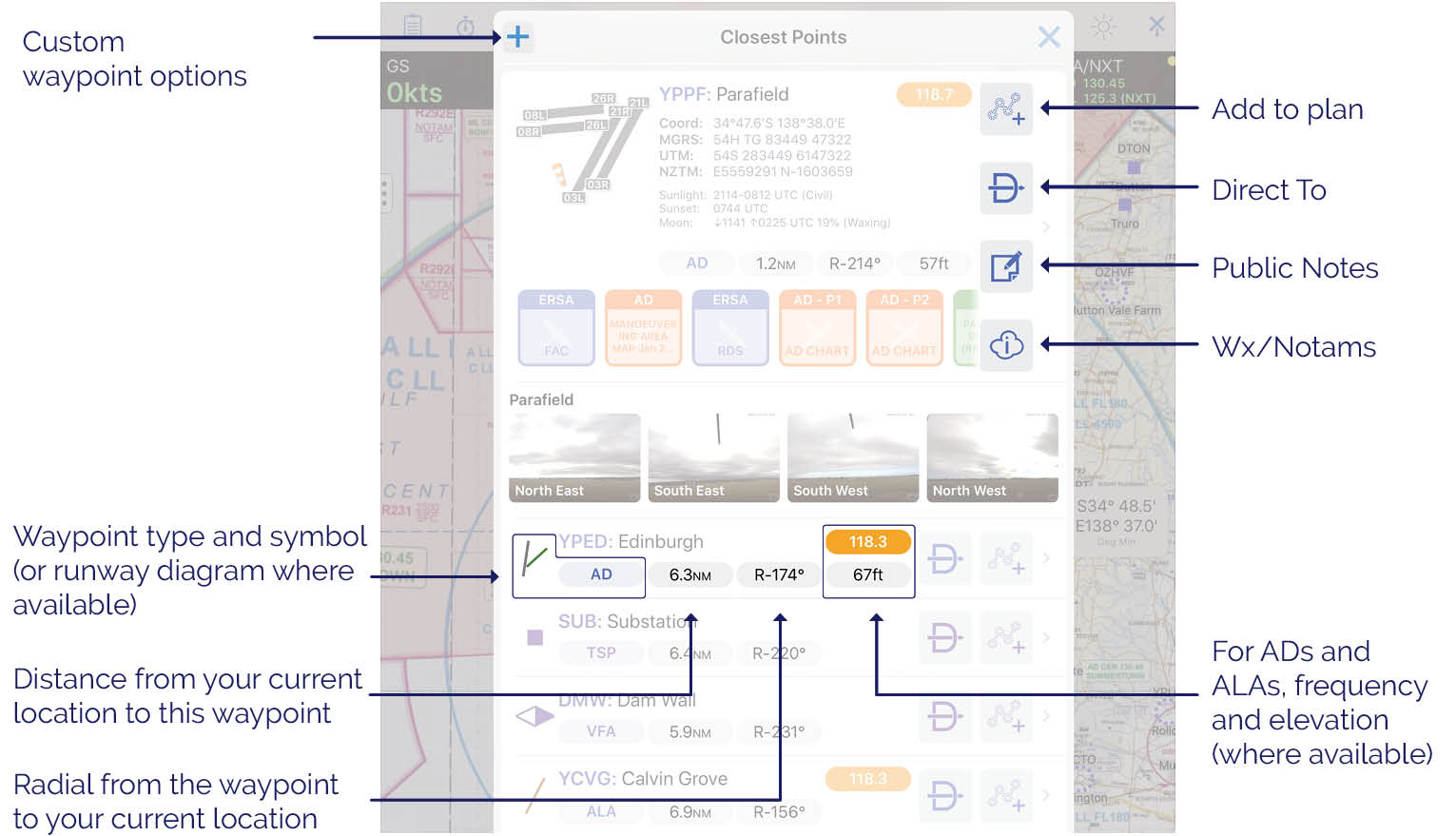
Image 2.1 Closest Points popup¶
Note
You can choose the type of waypoints that appear in the ‘Closest Points’ popup in Settings → Preferences → Waypoint Sub-Types.
If you have tapped in an area with few waypoints you will see ‘New Custom Waypoint’ at the top of the list (Image 2.2). This item is used to create a User Waypoint. To learn more about creating & editing User Waypoints see the User Waypoints chapter. If the ‘New Custom Waypoint’ option does not appear in the list you can use the ‘+’ symbol in the top left corner to create a User Waypoint.
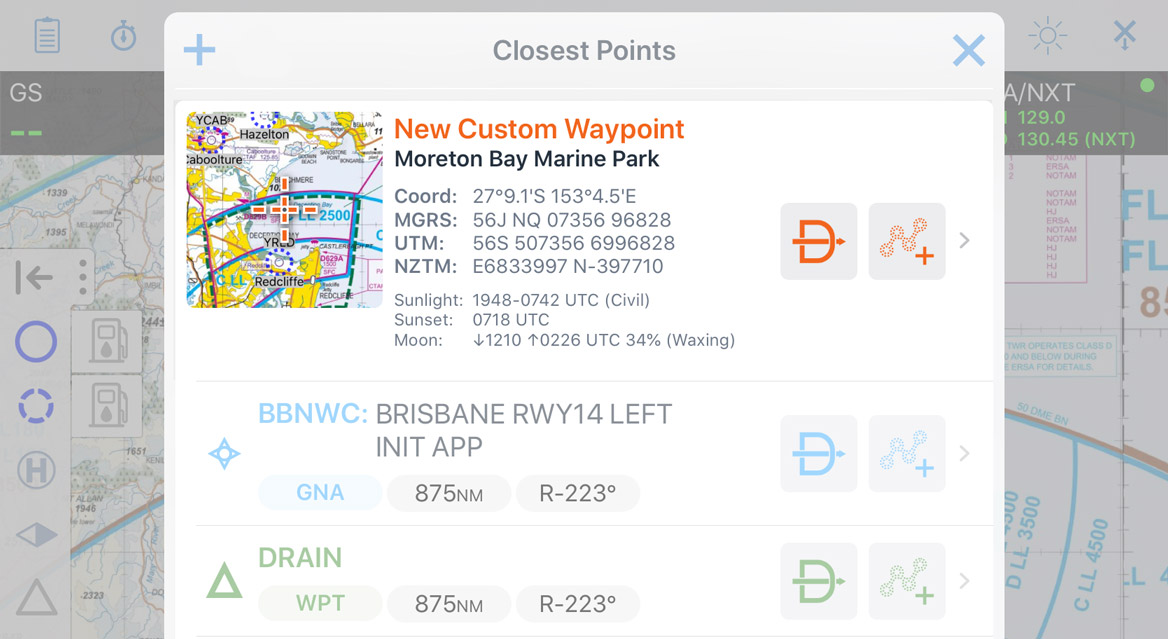
Image 2.2 Closest Points popup showing ‘New Custom Waypoint’ option¶
Tap on a waypoint for more options (Image 2.3). The options are described below.
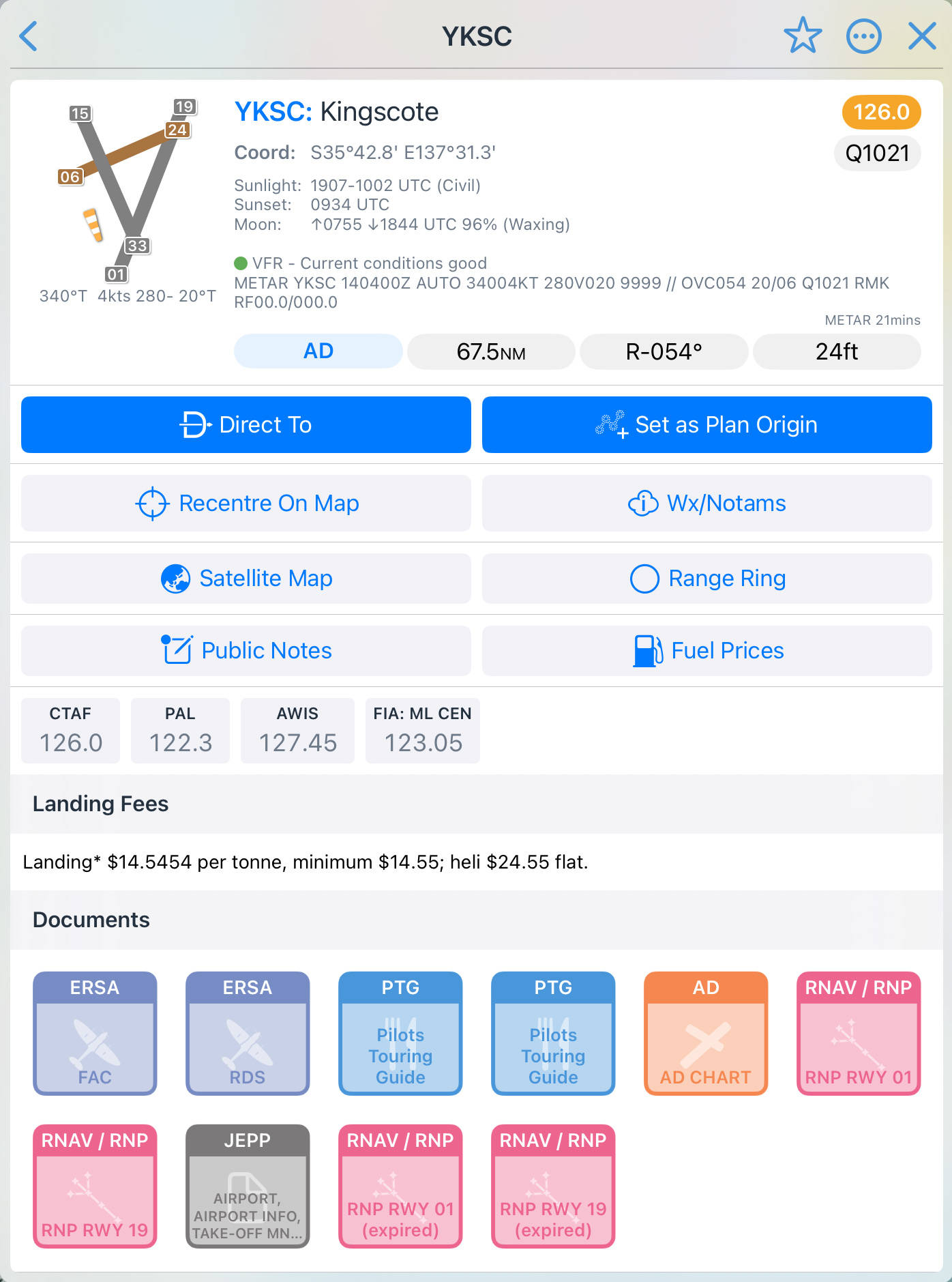
Image 2.3 Waypoint Details view¶
- Direct To
When you select ‘Direct To’, a User Waypoint is dropped at your current position and a plan is constructed from the newly created User Waypoint, to the selected waypoint. If you were already in a plan, that plan will continue after reaching the ‘Direct To’ point.
‘Direct To’ is a handy option for a quick change of plan, e.g. a diversion. There are better ways to create an actual flight plan, these methods are described in the chapter on Planning
- Set As Origin of Plan / Add To Plan
Tapping ‘Set As Origin of Plan’ creates a flight plan with the selected waypoint as the initial point in the plan. (If you already have a plan active, the button will be labelled ‘Add To Plan’) This is one method you can use to create a flight plan. To add more waypoints to your plan: tap near the desired waypoint on the map → select the waypoint in the subsequent Closest Points Popup → tap ‘Add To Plan’. For more information see the chapter on Planning.
- Remove From Plan
(Only shown if this waypoint exists in the currently active plan) Removes the waypoint from the plan.
- Recentre On Map
Positions the screen with the selected waypoint in the centre.
- Wx/Notams
Tapping on ‘Wx/Notams’ results in a tabbed popup that provides access to various weather & NOTAM information.
The options here are covered in the Weather chapter.
- Satellite Map
Opens a Satellite Map popup with the waypoint shown as a pin drop on the map.
- Range Ring
The Range Ring feature is discussed in Special Features
- Public Notes
Use the Public Notes system to share information about airfields with other OzRunways users. Before you can submit a Public Note you will need to set up a nickname in Settings → Subscriptions.
- Fuel Prices
For waypoints that have associated fuel prices, these are shown here. Tap to edit or enter new fuel information.
- Frequencies
Frequencies associated with the airfield are displayed and categorised here. Some can be expanded by tapping on them. UHF frequencies are only displayd if the Active/Default aircraft profile has ‘UHF’ equipment capability.
- Landing Fees
Some airports have landing fees published from various third party sources. These are updated regularly but should be verified against the source data for accuracy. Press the ‘i’ info button (if present) for extra information.
Below these options a list of documents for the airfield is shown. Tap a document to view.
Toolbars¶
There are a number of toolbars around the edge of the map, the function of these toolbars and their buttons are described below.
2.5. Bottom Left Bar¶
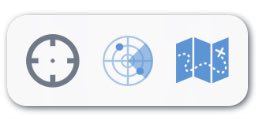
Map Mode¶
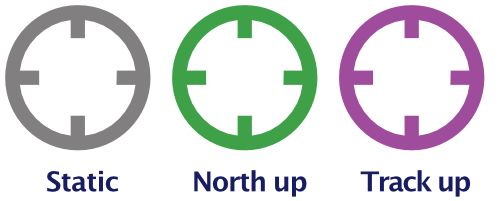
The Map Mode button toggles between static mode (where the map does not move) and moving map modes (where the map tracks your GPS position).
There are two moving map modes: North Up and Track Up. Cycle between the modes by tapping on the Map Mode button. Static → North Up → Track Up → Static … etc. etc. The current Map Mode is denoted by the colour of the Map Mode button. It is clear (grey) in static mode, green in North Up mode, and magenta (or purple) in Track Up mode.
In order for the moving map modes to work, the iPad needs to know your GPS position, which means you need to have the iPad’s Location Services turned on. When you tap the Map Mode button and transition into one of the moving map modes, the map will recenter and place your aircraft symbol in the centre of the screen (North Up mode), or in the bottom third of the screen (Track Up mode).
In Track Up mode a North pointer appears inside the map mode button showing the direction of magnetic North. You may pan or zoom the screen to wherever you want and the tracking will continue with the offset and zoom you have selected.
Radar¶

The Radar Button brings up a popup with three options: a Windy.com weather display, the closest Bureau of Meteorology (BoM) radar to the middle of the screen, and the national Satview (satview.bom.gov.au).
The features in this popup are covered in depth in the chapter on Weather
Choose Map¶

The ‘Choose Map’ button lets you select the map you wish to display. The maps shown in the list are based on the current location you are viewing on screen.
Image 2.9 shows a typical Choose Map popup in the vicinity of Melbourne.

Image 2.9 Choose Map popup¶
Tap on the VFR or IFR boxes to show/hide the VFR or IFR maps. In Image 2.9 both VFR and IFR are selected.
Maps are listed top to bottom in decreased order of detail (or scale). So, for instance, the National 250k Topographical map is listed at the top as it is the most detailed map for that area. As you get into more rural areas, only the WAC and perhaps the ERC (Low/High) will show. The Hybrid VFR and ERC Low National always appear at the top of the list as these are the most frequently used.
The currently selected map is highlighted blue (e.g. in Image 2.9 the Melbourne VNC is the selected map).
The WAC (AU) is a global map for Australia derived by combining all individual WACs. This means there is no need to select or know the particular WAC you need for a given area. We have similarly created a nation-wide ERC for both Low and High versions (named ERC Low National and ERC High National respectively). However, the individual ERCs are still selectable as on some occasions, the boundary of one ERC may overlay detail on an adjacent ERC that is required. In that case you can swap to the individual ERC in question.
There is also a Hybrid VFR map provided for Australia which when zoomed out shows the WAC. As you zoom in, and if they are available, you will see in sequence, the VNC, VTC and inset for the area at which you are looking.
If a legend is available for the selected map, the word ‘Legend’ will display in the top left corner of the popup on iPads. On iPhone it will also appear at the very bottom of the list of maps.
If you have not downloaded a particular map, a ‘cloud’ icon displays next to it on the right. You can tap the cloud to download the map here rather than going to Settings → Downloads. Once tapped, the download progress will be shown. If you want to delete a map, you still have to go to Settings → Downloads → (Country) and perform that action there.
2.6. Bottom Right Bar¶
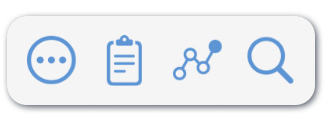
More Options¶

Note
This icon is only shown when a plan is open/active
The More Options button contains options for the currently active plan. If you have an appropriate subscription avionics export options for Avidyne and Dynon will appear in this menu.
Plan Sheet¶

Tap to open the Plan Sheet for the currently active plan. The function of the Plan Sheet is covered in Planning.
Plans (lines and dots)¶

The Plans screen is divided into two sections. The top section contains the Quick Planner and the bottom section contains the list of previously created plans. For more information on making a plan and accessing saved plans see the chapter on Planning
Tapping Plans when a flight plan is already active will result in the Plan Details view, as described in the Planning chapter.
Search¶

The Search button allows you to search for an airport or waypoint by name, partial name, ICAO code, or a distance and bearing (YBAF04015). It also provides you with the closest ADs, ALAs and other waypoints relative to your current GPS position. It is often useful if you have to do a quick diversion. For example: tap ‘Airports’ to view a list of AD, ALA, and HLS closest to your current GPS position. Or, type in the search box to search for a waypoint manually. You can also perform an Apple Maps search e.g. try searching for ‘The Big Rocking Horse’. This popup may be left open and distance and bearing information will continue to update (potentially useful if you are approaching a waypoint and want a quick view of the distance remaining).
2.7. Traffic / Timers¶
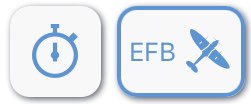
Traffic¶
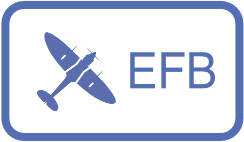
The elements of the traffic icon gives a visual indication of the status of both the OzRunways traffic system, and any connected ADS-B device.
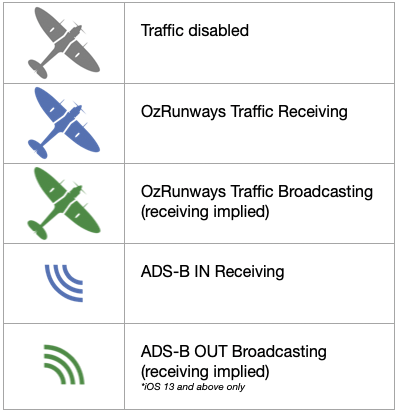
Image 2.10 Traffic icon legend¶
Single-tap the traffic icon to reveal more options. Tap and hold to momentarily enlarge all traffic. If you have a SkyEcho connected this is where you can configure the settings. (iOS 13 or above required)

Image 2.11 Left: Standard traffic popup Right: Popup with SkyEcho connected (iOS 13 or above required)¶
The image below demonstrates the appearance of the traffic icon under the following conditions:
OzRunways traffic broadcasting
SkyEcho ADS-B OUT broadcasting using callsign EFB, and squawk code 1200
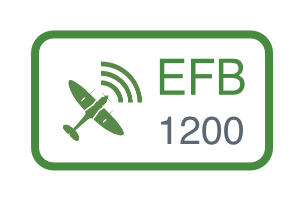
Note
The OzRunways traffic system will only broadcast your position to other users when it detects you are flying. i.e. the aeroplane symbol won’t be green unless you are flying.
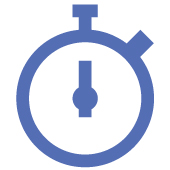
Tapping the Timers button opens a menu where you can access the Flight & Engine Timer settings.
- Engine Timer
There is an engine timer and a flight timer. You can start the timers manually, or have them automatically start. The engine timer may be started automatically by listening for ambient engine noise. This is setup by tapping the Volume Switch and then tapping ‘Auto’ and adjusting the volume control while you have your engine running. Adjust volume from highest to lowest so that the timer starts reliably. When the engine is stopped, the timer should automatically stop. You may have to experiment with the setting to get it right for your aircraft.
- Flight Timer
The flight timer may be automatically set by tapping ‘Air Switch’ and selecting an air speed at which you wish to start the flight timer.
The respective timers may be reset at the bottom of the popup. If the timers are set and operating, their values are displayed to the right of the timers icon.
2.8. Airspace¶
The left screenshot in Image 2.12 shows the result of a long press near YPED (Edinburgh, SA). On releasing your finger after a long press a list appears detailing the airspace under your finger at the time you did the long press. The types of airspace that appear in this list can be selected in Map View Options (cogs). A tap on the bottom airspace listing (Edinburgh airspace R234) results in the display on the right in Image 2.12.
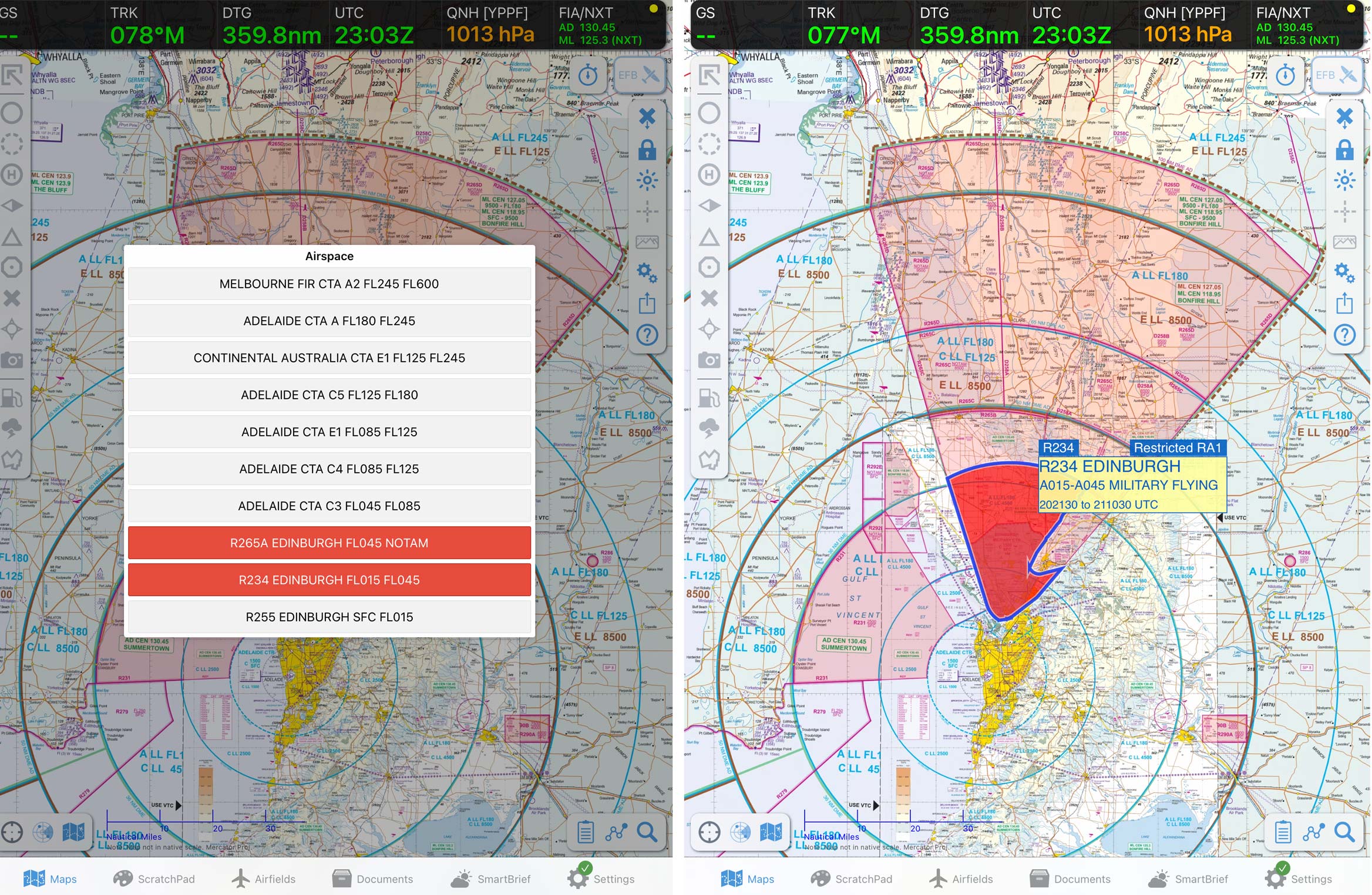
Image 2.12 Airspace information¶
When viewing restricted airspace details in the above manner the information box will be coloured either yellow, orange or red. The orange colour indicates that clearances may be given to transit that airspace (i.e. RA2). A red colour indicates you are unlikely to get a clearance through the airspace (RA3) and yellow illustrates that clearances are routinely given (RA1).
The active hours (where available) are shown in UTC.
2.9. GPS HUD¶
Below the title bar menu there are a number of dark boxes which display information. This is called the GPS HUD and is described in detail in the GPS HUD chapter.

Image 2.13 GPS HUD¶

